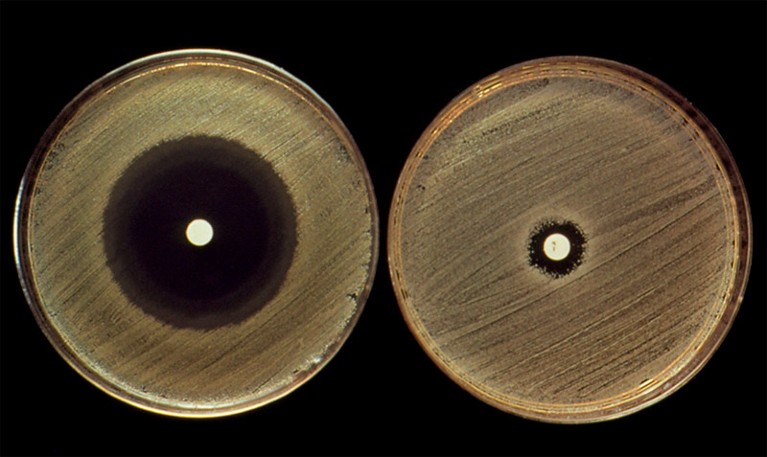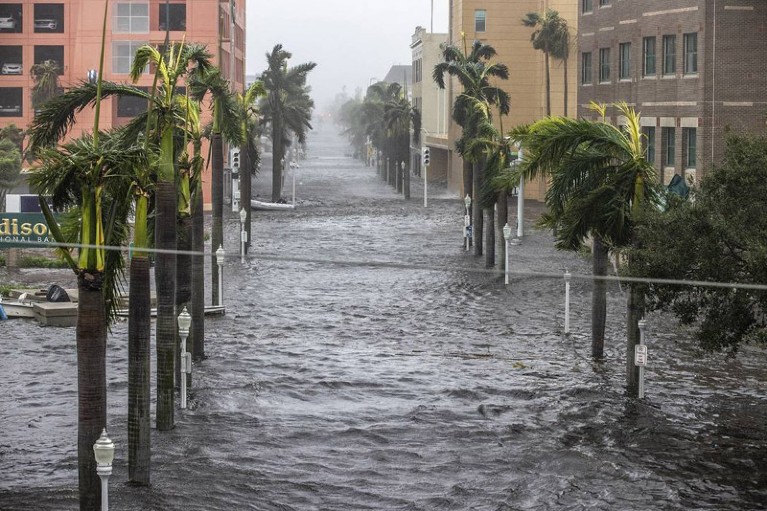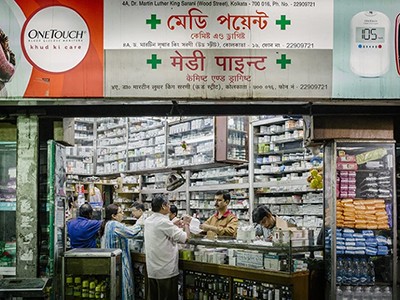In 2021, microbiologist Adwoa Padiki Nartey caught a bacterial an infection and her tonsils began to swell. She’d had the identical signs the yr earlier than; each diseases occurred throughout one in every of two annual wet seasons in Ghana’s capital, Accra, the place she lives. In these seasons, she knew, excessive humidity and moisture spur microbial development. Docs prescribed antibiotics however, in contrast to earlier than, the medicine didn’t work. The micro organism had turn into resistant.
Over two weeks, her tonsils grew to become more and more infected. “It was painful to drink. Painful to eat. I might barely converse,” says Padiki Nartey, who researches antibiotic resistance on the College of Ghana in Accra. “I used to be nervous.”
To her reduction, a ultimate mixture of two forms of antibiotic labored. In any other case, the an infection might have killed her, she says. “That’s fairly scary.”
The battle in opposition to antimicrobial resistance
The episode demonstrates how two main threats to human well being — local weather change and the unfold of antibiotic resistance — can intersect. Local weather change has led to extra frequent heavy rainfall in Ghana, Padiki Nartey says. These circumstances, in flip, encourage bacterial development, together with that of antibiotic-resistant microbes. Flooding additionally spreads antibiotic-resistant micro organism from sewage methods into folks’s houses and ingesting water, she provides.
Though researchers have some understanding of how local weather change will exacerbate the rise in antibiotic resistance, scientists at the moment are digging into the mechanisms and exploring how giant the impact might be, says Pamela Yeh, an evolutionary biologist on the College of California, Los Angeles. “Local weather change and antibiotic resistance are two of the most important well being problems with our time,” she says. “Researchers are beginning to have a look at how they hyperlink up.”
Climbing resistance
Drug-dodging micro organism are on the rise. In 2020, human blood infections brought on by antibiotic-resistant Neisseria gonorrhoea, Escherichia coli and Salmonella micro organism grew to become not less than 15% extra frequent than in 2017, in accordance with a report revealed by the World Well being Group (WHO) in 2022. We’re hurtling in direction of a world the place scraping your knee, giving beginning or having a easy surgical process might kill you, says Yeh. “It’s extremely scary,” she says.
The important thing downside is that antibiotics are sometimes overused or misused to battle infections in folks, different animals and crops. Micro organism can develop resistance to medicine by way of DNA mutations that alter the bacterial cell wall such that antibiotics can’t work, or that confer skills to interrupt down antibiotics or pump them out of cells. Strains that turn into resistant may share antibiotic-resistance genes with different micro organism. If the improper antibiotics are given to deal with infections, or if the suitable medicine are taken at inadequate doses to kill the microorganisms, then the microbes have extra time to multiply and to evolve or unfold resistance.
However as in Ghana, altering climate circumstances that assist micro organism thrive additionally play a component. And disasters stemming from excessive climate occasions reminiscent of floods, droughts, hurricanes and wildfires can exacerbate the problem as a result of they usually scale back entry to wash water, resulting in unsanitary circumstances. When accidents and infections begin to rise, extra folks use antibiotics, in flip pushing up the chance of resistance growing.
In a examine1 revealed final October, microbiologist Rita Colwell on the College of Maryland in Faculty Park and her colleagues confirmed {that a} lethal hurricane had led to a spike in dangerous species of antibiotic-resistant Vibrio micro organism — together with a flesh-eating species — in waters off the coast of Florida. The excessive winds whipped up vitamins from marine sediments that the micro organism thrive on, says Colwell.
Temperature adjustments
Past the bodily injury brought on by excessive climate, researchers are exploring how rising temperatures that consequence from local weather change would possibly affect antibiotic resistance. In November 2022, microbiologist Lianping Yang at Solar Yat-sen College in Guangzhou, China, and his colleagues reported on the prevalence of three micro organism behind antibiotic-resistant hospital infections which can be usually extreme and could be lethal: Acinetobacter baumannii, Klebsiella pneumoniae and Pseudomonas aeruginosa2.
The researchers appeared for hyperlinks between temperature and antibiotic resistance by evaluating bacterial knowledge — collected from folks handled in hospitals in 28 provinces and areas throughout China — with data on common air temperatures in cities in the identical areas. The group corrected for elements that might have an effect on charges of drug resistance, together with the extent of antibiotic consumption, common humidity, yearly rainfall and inhabitants density.
They discovered that, for each 1 °C improve in common air temperature, there was a 14% improve within the proportion of samples containing Ok. pneumoniae that had been immune to a sort of antibiotic referred to as carbapenems. These medicine are normally reserved for treating micro organism which can be immune to all different antibiotics.
Yang and his colleagues additionally linked a 1 °C improve in common air temperature to a 6% improve within the proportion of samples containing carbapenem-resistant P. aeruginosa. However temperature didn’t considerably have an effect on the prevalence of drug-resistant A. baumannii.

Extensively used antibiotics reminiscent of penicillin (in white spots) can have very totally different results on associated bacterial strains (opaque growths).Credit score: John Durham/SPL
These findings help research from 2018 and 2020 by microbiologist Derek MacFadden on the College of Ottawa and his colleagues3,4. The group discovered that elevated common minimal temperatures had been linked to increased charges of antibiotic resistance throughout 41 states in the US3 and 28 nations in Europe4. Nevertheless, the research don’t present a causal hyperlink between temperature and antibiotic resistance, says Yang.
A technique that gradual will increase in common air temperature might be driving up antibiotic resistance is by rising the expansion fee of micro organism, rushing up their evolution, says MacFadden. There’s additionally proof that micro organism can share genes — together with components that confer antibiotic resistance — extra simply in heat circumstances than in chilly ones5.
Excessive circumstances
One other concept is that very excessive temperatures — that are skilled extra usually because the globe warms, despite the fact that common temperatures rise solely barely — would possibly induce genetic adjustments in micro organism that assist them to withstand antibiotics, says Yang.
In a 2018 examine, Yeh and her colleagues uncovered E. coli, which grew greatest at 41 °C, both to a temperature of 44 °C or to a variety of 12 antibiotics (intentionally given at low doses to inhibit however not kill all of the micro organism)6. The researchers tracked how the micro organism responded to those stressors, and located that patterns of gene expression modified in related methods for each temperature and antibiotic kind. In each instances, micro organism responded to the stress by producing extra ‘heat-shock’ proteins. These assist different proteins to fold appropriately and apparently additionally assist micro organism to outlive antibiotic assault, says Yeh. “We generally name antibiotics that mimic [the effects of] scorching circumstances ‘scorching’ medicine,” she says.
When E. coli was uncovered to temperatures as little as 22 °C, the microbes ramped up ‘cold-shock’ proteins — once more serving to them to supply the proteins wanted for survival. Some ‘chilly’ antibiotics, reminiscent of tetracycline, altered bacterial gene exercise in an identical method.
COP28 local weather summit alerts the tip of fossil fuels — however is it sufficient?
The findings counsel that micro organism which have developed in extraordinarily scorching or chilly circumstances is perhaps extra immune to sure antibiotics, Yeh says. However in a examine that’s but to be revealed, Yeh’s group discovered that publicity to excessive temperatures generally makes micro organism much less immune to ‘scorching’ antibiotics, highlighting that the hyperlinks between temperature and resistance are prone to be advanced, she says.
Excessive temperatures might additionally contribute to antibiotic resistance by altering how folks work together with one another, says MacFadden.
In South Korea, “once we attain the very best temperatures, folks have a tendency to remain inside”, says microbiologist Soojin Jang on the Pasteur Institute Korea in Seongnam. Micro organism are inclined to unfold significantly simply between people who find themselves in shut contact with one another indoors, she says. That would assist to unfold resistant strains, and — as a result of extra micro organism are multiplying in additional folks — improve the prospect that resistance will emerge.
Over the previous yr, Jang and her group have been monitoring the presence of antibiotic-resistance genes in bacterial samples collected from public bogs, trains and buses. The researchers hope to proceed this over the following decade and evaluate charges of antibiotic resistance with elements reminiscent of native air temperature and social behaviour. This might assist to disclose how local weather change is affecting the unfold of resistance, says Jang.
Tackling resistance
Surveillance reminiscent of Jang’s might be allied with local weather and climate knowledge to assist observe or predict the unfold of antibiotic-resistant micro organism, says Colwell. In a examine revealed final February, she and her colleagues used elements together with temperature and rainfall knowledge from satellites to foretell when and the place cholera outbreaks — brought on by the waterborne micro organism Vibrio cholerae — would happen7. Their machine-learning mannequin predicted the danger of cholera outbreaks in numerous areas throughout Yemen with a mean accuracy of 72%, and as much as 4 weeks upfront.
Combining climate knowledge with surveillance for antibiotic-resistance genes by monitoring waste water might enhance forecasts for areas which can be at a excessive danger of antibiotic resistance, Colwell says. It’s an method her group is engaged on.

Hurricane Ian precipitated flooding within the streets of Fort Myers, Florida, in 2022.Credit score: Pedro Portal/Miami Herald/Tribune Information Service through Getty
Moreover bettering surveillance, researchers already know what’s wanted to scale back the unfold of antibiotic-resistant micro organism: bettering entry to wash water and sanitary services, and elevating consciousness of learn how to use antibiotics appropriately.
Some efforts have been profitable. In Lebanon, for example, clinician and infectious-disease researcher Souha Kanj says a programme that she and her colleagues began on the American College of Beirut in 2018 educated physicians on learn how to scale back the usage of carbapanem antibiotics of their hospital. In 2020, the proportion of A. baumannii infections that had been carbapenem-resistant had fallen to 63%, from 81% at the beginning of the programme8.
Padiki Nartey, in the meantime, is amongst these attempting to develop new methods to kill drug-resistant micro organism. One significantly promising method is to use viruses referred to as phages, which infect micro organism, however not human cells.
International motion
Researchers searching for to stem the rise of antibiotic resistance might additionally be taught classes from climate-change politics, says Steven Hoffman, a world lawyer and health-policy researcher at York College in Toronto, who can also be on the Public Well being Company of Canada. Such world threats don’t respect nationwide borders, says microbiologist Saffiatou Darboe on the College of the Gambia in Serrekunda. So, drawing parallels with local weather change, nations ought to agree a world treaty to sort out the problem, Hoffman says.
In 2015, the WHO launched a International Antimicrobial Resistance and Use Surveillance System (GLASS), which helps to trace the worldwide consumption of antibiotics and the prevalence of frequent antibiotic-resistant infections. These knowledge are used as an indicator within the United Nations Sustainable Improvement Targets to observe progress on tackling antimicrobial resistance.
The world’s objectives to avoid wasting humanity are vastly formidable — however they’re nonetheless the most suitable choice
However stronger motion is required, says Hoffman. In a 2022 examine9, he and his colleagues referred to as for a treaty to sort out drug-resistant pathogens — equal to the 2015 Paris local weather settlement. He desires nations to articulate a single unifying objective, reminiscent of a 35% discount in drug-resistant infections by 2035, and hopes that they may make progress on this once they convene at a UN assembly on antimicrobial resistance in September. The assembly is just the second time that the problem has been the topic of a UN Basic Meeting.
And simply as richer nations have agreed to pay poorer ones to assist cope with the consequences of local weather change, so they need to financially help poorer nations dealing with a better prevalence of antibiotic resistance, Hoffman provides. “Richer nations have benefited for for much longer from antimicrobials,” he says.




